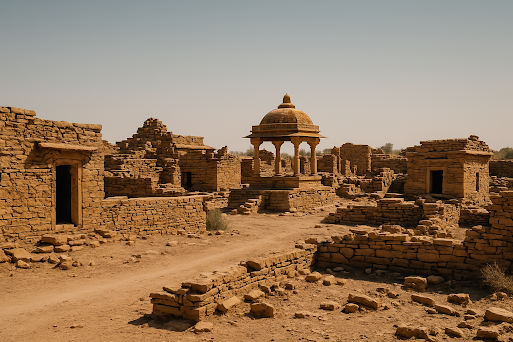🌊 Lothal: Gujarat's Ancient Port City (Made Easy!)
📍 Where?
- Near Ahmedabad, Gujarat. Today, it’s a quiet ruin — but 4,000 years ago, it was the Dubai of the Indus Valley!
🕰️ When?
- 2400–1900 BCE (That’s older than the Egyptian pyramids!)
🚢 What Made Lothal So Special?
🔧 The Dockyard:
- Lothal’s dockyard was an architectural marvel of its time — a massive rectangular pool (roughly the size of two tennis courts) with stone-lined channels designed to accommodate ships.
- Proof it worked? Archaeologists found seashells and salt residues, confirming it was designed to hold seawater. Lothal was an important trade hub, linking the Indus Valley with Mesopotamia (modern-day Iraq) through trade of gems, beads, cotton, and ivory.
🚽 Toilets & Drains:
- Every house in Lothal had its own bathroom, complete with an advanced drainage system.
- It’s incredible that 4,000 years ago, Lothal had better planning than some modern towns do today!
🔬 Tiny Beads, Big Deal:
- Lothal’s craftsmen were masters at creating micro beads, smaller than rice grains, for use in jewelry. These required magnifying lenses to fully appreciate — a testament to their advanced techniques.
🏚️ Lothal's Decline and Rebuilding:
- Though Lothal flourished for centuries, the city eventually faced devastating floods and storms around 1900 BCE. These natural catastrophes submerged much of the town, destroying houses and severely damaging public infrastructure.
- The people of Lothal showed incredible resilience. Despite the destruction, they rebuilt using makeshift materials, though the quality of construction was much poorer. The river’s course shifted, cutting off access to the dock, and the city's economy and trade suffered.
- Interestingly, despite these setbacks, Lothal’s craftsmen continued to create goods, such as beads and pottery, albeit on a smaller scale. The Harappan system of weights, pottery, and even writing endured, though it became less sophisticated. Public baths and drainage systems were still in use, but many of the city’s important structures, like the warehouse, were left in disrepair.
🏗️ Architectural Resilience:
The people of Lothal rebuilt their homes and public works without completely removing the debris from previous floods. Though the structures were poor in quality and more susceptible to further damage, they managed to sustain some of their key industries. The bead factories and craft workshops were still functional, a testament to the durability of their industry even in times of hardship.
🤔 What You’ll See Today (Still Cool!):
-
Ancient Dockyard — walk where Harappan sailors stood
-
Bead Factory Ruins — early evidence of organized industry
-
Museum — toys, tools, seals, and skeletons from 2400 BCE
-
Burial Sites — see ancient burial chambers
🧠 Did You Know?
The name “Lothal” means ‘Mound of the Dead’ in Gujarati. Locals still call it that. Spooky, huh?
🚗 Planning a Visit to Lothal?
📌 Location:
-
Distance: 85 km from Ahmedabad (~2–2.5 hours by road)
-
Nearest Railway: Lothal-Bhurkhi (6 km, but limited trains)
-
Easiest Access: Drive or hire cab via Dholka town
Distance: 85 km from Ahmedabad (~2–2.5 hours by road)
Nearest Railway: Lothal-Bhurkhi (6 km, but limited trains)
Easiest Access: Drive or hire cab via Dholka town
🕒 Best Time to Go:
- ✅ October to March: Best weather (15–30°C)
-
🚫 April to June: Extremely hot (up to 45°C)
-
⚠️ July to September: Risk of monsoon flooding
🚫 April to June: Extremely hot (up to 45°C)
⚠️ July to September: Risk of monsoon flooding
⏰ Site Timings:
-
Lothal Site: 10 AM – 5 PM (open daily)
-
Museum: 10 AM – 1 PM & 2 PM – 5 PM (Closed on Fridays)
🎟️ Entry Fees (May Vary):
-
👤 Indians: ₹25 (adults), ₹15 (kids)
-
🌍 Foreigners: ₹300 (includes museum)
-
👶 Children below 15: Free
🎯 Pro Tips:
🔍 Hire a local guide (~₹200–300) to decode the site’s secrets
👟 Wear comfy shoes — uneven terrain
📸 Great for history lovers and photographers
🍽️ Carry snacks or eat in Dholka — limited food options on site
⚠️ Heads-Up:
🌞 Very little shade — bring water, hat & sunscreen
🧠 The dockyard looks like a large empty tank today — use imagination!
🚗 Limited public transport — private vehicle is ideal
💡 Why Does Lothal Matter?
-
🔧 It proves ancient Indians were engineering geniuses
-
🌍 It had global trade connections long before Europe did
-
🧠 It shows innovation, not just kings and wars
-
❓ It’s still a mystery — why did it collapse? Earthquake? Floods?
✨ TL;DR:
Lothal = India’s ancient port city with the world’s oldest dock, smart drainage, global trade, and unanswered mysteries. A must-visit gem in Gujarat! 💎
"Lothal's story reminds us: our so-called 'ancient' ancestors were truly brilliant innovators."





Comments
Post a Comment